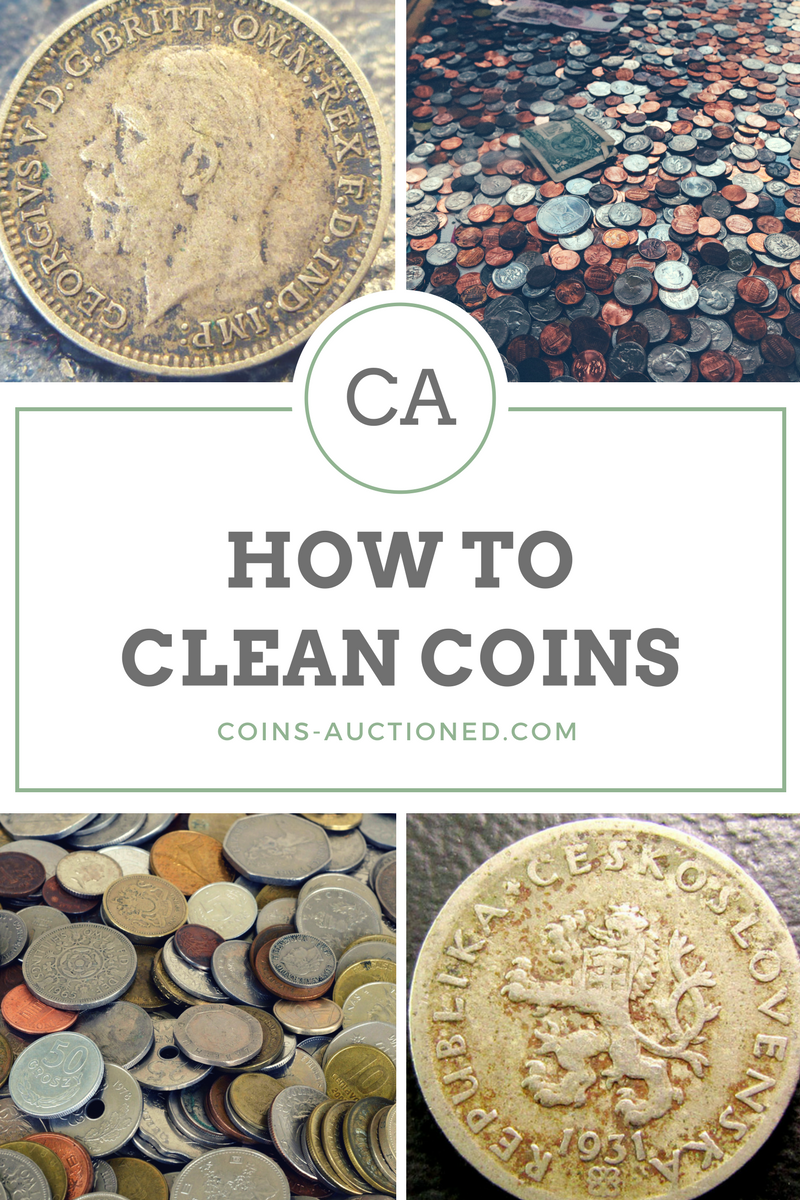
发布时间13th Mar 2018
修改于30th Jul 2024
如何清洁硬币
 你应该清洁硬币吗?你应该什么时候清洁硬币?你应该如何清洁硬币?
你应该清洁硬币吗?你应该什么时候清洁硬币?你应该如何清洁硬币?
在钱币世界里,你总会听到经销商说“不,你永远不应该清洗钱币”。这样做的主要原因是为了防止人们犯错误,尤其是那些古老、稀有或有价值的钱币。如果钱币从未清洗过,你在 Coins-auctioned.com 和其他地方看到的许多古钱币都会变成一团团的泥土。许多古钱币来自地下,需要清洗后才能被识别为钱币。甚至第三方评级服务也提供钱币养护服务,本质上就是清洗。
首先,不要清洗稀有或贵重的硬币,一定要寻求专业建议。如果清洗不仔细,硬币的价值几乎会全部流失。
重要的是要认识到清洁有不同的级别,有些被视为常见的做法,有些则不是,有些则永远不应该发生。
清洗。只需在清水中清洗和冲洗硬币即可。这不会去除污渍或锈迹,但可以去除大多数探测器或考古发现上的污垢。
机械清洁器,例如超声波清洁器。应小心谨慎地使用这些清洁器。它们非常适合去除表面污垢,并在一定程度上去除贱金属硬币上的一些腐蚀,但很容易过度使用而损坏硬币的外观。
浸泡。浸泡可以是任何方法,从将硬币快速浸入丙酮中以去除油和沉积物(包括乙烯基硬币盒中的残留物),到使用专业的硬币清洁剂,再到使用有毒化学品和酸。其中一些化学品可能会不可逆转地改变硬币的外观,因此必须小心使用。
抛光。这是使用任何研磨剂去除表面材料或增加“光泽”的过程。如果您将硬币用于工艺项目,那没问题,但对于收藏家来说,这绝对是不行的。研磨剂会损坏硬币的表面,去除铜绿并添加自己的细节,这不是收藏家想要看到的。
如果清洗后,您拥有的古代贱金属硬币表面呈红色或棕色粉末状,锌币的细节无法很好地显示出来,您可以涂上一层薄薄的微晶蜡,例如 Renaissance Wax。这种处理是可逆的,可以随时去除,但可以帮助保护一些硬币。
非常重要的一点是,您要记录对硬币所做的一切,以便您想将其出售或赠送给其他收藏家,让他们知道自己拥有什么。
再次强调,不要清洁稀有或贵重硬币。大多数收藏家不会或很少清洁硬币,因为这会大大降低其价值。如果您有一些价值较小的硬币,如 10 美分或 1 美分硬币,那么本文适合您。
铜绿是硬币上经过多年形成的一层薄薄的锈蚀或色调,许多硬币收藏家都喜欢这种锈蚀,因为有时锈蚀会非常美丽。在对硬币进行评级时,铜绿可能是一个因素。
铜锈在铜和青铜硬币上可能呈绿铜色或褐色,在银币上则呈彩虹色、灰色或黑色。最好不要清除稀有硬币上的铜锈,因为这样会降低其价值。绝大多数硬币在清洗后不会升值,但如果您有一些想要清洗的旧硬币,请尝试以下步骤。
我们抽屉里都有脏兮兮的硬币,甚至还有某种气味,幸运的是,其中大多数都是低面值硬币,您可以享受清洁它们的乐趣,因为大多数只是零钱。
用流水冲洗硬币。握住硬币的边缘。
蒸馏水是最好的,因为现在大多数水都经过氟化物处理,这可能会与一些硬币发生不同的化学反应,因为许多硬币是由不同金属组合而成的。
将硬币浸泡在醋中约一分钟。
在流动的温水中冲洗并充分冲洗硬币。
风干,而不要使用干布。
另一种方法是用吸水纸拍干或吸干,只能轻轻擦拭,不要擦拭或擦拭。
如果仍然很脏,您可以使用软刷(例如儿童牙刷)清除结块的污垢。按照上述方法干燥。
清洁银币的方法
完成与上述相同的过程,并在柠檬汁中浸泡 5 分钟,有助于保持硬币的光泽。
99.99% 纯银的加拿大硬币确实存在乳斑问题。乳斑是加拿大皇家铸币厂硬币表面出现的乳白色物质。这是由于铸币过程和微小的氯化银碎屑造成的。 
珀斯铸币厂的硬币没有这些问题,因为他们更新了设备,而且很少能找到有这些奶斑的澳大利亚银币,但加拿大皇家铸币厂 (RCM) 仍然存在这个问题。加拿大皇家铸币厂曾表示,他们的硬币不是收藏币,而是金条,所以这不是他们打算解决的问题。他们不认为金条是流通币或供收藏者使用。因此,在购买 RCM 硬币时请注意,它们可能在某个阶段有奶斑。
枫叶银币似乎是受影响最严重的银块。纯度超过 .999 后,要达到 99.99% 的纯银似乎非常复杂。有些人用铅笔橡皮擦或银布清洁银饰。最好将 RCM 硬币放在胶囊中,但有些 NGC 胶囊在密封后会出现斑点。
铜币
大多数国家都铸造了大量面额较小的铜币,但其中一些设计水平很高,所以很容易理解为什么人们想要清洗这些铜币。英国的一便士硬币设计精美,不列颠尼亚面朝右坐着,戴着头盔,手握三叉戟,手放在盾牌上,最著名的铜币是 1808 年海军上将加德纳沉船硬币,深受全球钱币交易商的欢迎。欧洲铜币包括 1853-1856 年 (5) 的 5 美分,具有漂亮的罗马风格设计。人们想要清洗铜币的原因是为了去除铜氧化物,即这些铜器上常见的绿色锈迹。
清洁铜币的方法
将一汤匙食盐放在小容器里。
加入白醋来润湿盐。
将糊状物涂在硬币上,有些可能需要浸泡 5 分钟。
效果立竿见影。您可以使用番茄酱、番茄膏或柠檬汁,因为它们也是酸性的。
用温水冲洗并风干。

请勿将此方法用于贵重硬币,并小心不要让其进入眼睛。
如何清洁铜币
也可以用肥皂水或橄榄油清洗铜币,但不能使用初榨橄榄油,因为它可能会使金属失去光泽。
如何清洁金币
只将硬币浸泡在温肥皂水中。蒸馏水是最好的。
只将金币风干。黄金太珍贵了,不能冒着损坏的风险。
有些人确实会使用专门用于金饰的黄金清洁布。
古钱币
首先,决定你真的想清洁古文物吗?一些古钱币在被发现时可能完全被凝固的粘土或污垢覆盖,然后商业硬币经销商将它们浸泡在振动机上的液体肥皂中,这可以清洁和软化外层材料,使硬币和硬币上的铂金保持原样。如果你仍然认为你想清洁你的古钱币,那么,
将铜币浸泡在肥皂蒸馏水中,但切勿使用柠檬汁或醋。
将小苏打浸泡在肥皂水中可以帮助清洁硬币。
尝试使用酸性产品,但前提是你确定硬币的类型。
如果您不确定硬币的类型,可以使用辣酱,如塔巴斯科辣椒酱或墨西哥玉米卷酱,也可以使用可乐或可乐产品。

尖端
将硬币存放在密封的容器中,或者更好的是存放在硬币盒中。
如果您不确定,请使用商业硬币清洁器。
不要使用研磨剂来研磨硬币,因为它们很容易造成划痕。
请勿使用家用清洁剂清洁硬币。
请勿使用家用的银清洁剂或银抛光剂。
商店硬币
搜索Coin Encyclopedia
最新的文章
文章分类
Collection of articles providing lots of useful information on coins through the ages.
30文章数




